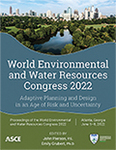Utilization of Network Subsystems for Designing a Level-1 Redundant Water Distribution Network
Publication: World Environmental and Water Resources Congress 2022
ABSTRACT
If some measurements of system reliability are not included, a least-cost optimization of a water distribution system (WDS) leads to a branched network. Utilizing network subsystems that provide an explicit level of system redundancy is one way to improve the performance of WDS networks. In this approach, the whole system is subdivided into two subsystem networks. Then, during the optimization phase, the two subsystems are simultaneously optimized so that each can provide some level of service to the consumer. Optimization results are ultimately determined by the pair of subsystems used. Unfortunately, there is little to no literature on the optimization of the selection of subsystems. The present study examines both the selection of subsystems and the optimization of the component sizes in designing a level-1 redundant network. Candidate subsystems are generated using graph theory where st numbering for the network is assigned first, and then the subsystems are generated following the decrement and increment orders of the node’s st-numbering. The optimization problem is solved using a genetic algorithm for backup selection and linear programming to compute optimal component sizes.
Get full access to this chapter
View all available purchase options and get full access to this chapter.
REFERENCES
Alperovits, E., and Shamir, U. (1977). Design of optimal water distribution systems. Water Resources Research, 13(6), 885–900. https://doi.org/10.1029/WR013i006p00885.
Dasgupta, A., Hopcroft, J., Kannan, R., and Mitra, P. (2006). Spectral clustering by recursive partitioning. In Lecture Notes in Computer Science (including subseries Lecture Notes in Artificial Intelligence and Lecture Notes in Bioinformatics): Vol. 4168 LNCS. https://doi.org/10.1007/11841036_25.
Gheisi, A., and Naser, G. (2015). Multistate Reliability of Water-Distribution Systems: Comparison of Surrogate Measures. Journal of Water Resources Planning and Management, 141(10), 04015018. https://doi.org/10.1061/(asce)wr.1943-5452.0000529.
Goulter, I. C., and Morgan, D. R. (1985). An integrated approach to the layout and design of water distribution networks. Civil Engineering Systems, 2(2), 104–113. https://doi.org/10.1080/02630258508970389.
Ormsbee, L., and Kessler, A. (1991). Optimal upgrading of hydraulic-network reliability By Lindell Ormsbee 1 and Avner Kessler 2. 116(6), 784–802.
Li, M., Liu, S., Zhang, L., Wang, H., Meng, F., and Bai, L. (2012). Non-dominated sorting genetic algorithms - II based on multi-objective optimization model in the water distribution system. Procedia Engineering, 37, 309–313. https://doi.org/10.1016/j.proeng.2012.04.245.
Ostfeld, A., Oliker, N., and Salomons, E. (2014). Multiobjective Optimization for Least Cost Design and Resiliency of Water Distribution Systems. Journal of Water Resources Planning and Management, 140(12), 04014037. https://doi.org/10.1061/(asce)wr.1943-5452.0000407.
Ostfeld, A., and Shamir, U. (1993). Incorporating reliability in optimal design of water distribution networks-review and new concepts. Reliability Engineering and System Safety, 42(1), 5–11. https://doi.org/10.1016/0951-8320(93)90049-5.
Ostfeld, A., and Shamir, U. (1996). Design of optimal reliable multiquality water-supply systems. Journal of Water Resources Planning and Management, 122(5), 322–332. https://doi.org/10.1061/(asce)0733-9496(1996)122:5(322).
Sirsant, S., and Reddy, M. J. (2020). Assessing the Performance of Surrogate Measures for Water Distribution Network Reliability. Journal of Water Resources Planning and Management, 146(7), 04020048. https://doi.org/10.1061/(asce)wr.1943-5452.0001244.
Takeaki, U. N. O. (1996). An algorithm for enumerating all directed spanning trees in a directed graph. Lecture Notes in Computer Science (Including Subseries Lecture Notes in Artificial Intelligence and Lecture Notes in Bioinformatics), 1178(C), 167–173. https://doi.org/10.1007/bfb0009492.
Tanyimboh, T. T., and Czajkowska, A. M. (2018). Joint Entropy Based Multi-Objective Evolutionary Optimization of Water Distribution Networks. Water Resources Management, 32(8), 2569–2584. https://doi.org/10.1007/s11269-017-1888-y.
Todini, E. (2000). Looped water distribution networks design using a resilience index based heuristic approach. Urban Water, 2(2), 115–122. https://doi.org/10.1016/s1462-0758(00)00049-2.
Information & Authors
Information
Published In
History
Published online: Jun 2, 2022
Authors
Metrics & Citations
Metrics
Citations
Download citation
If you have the appropriate software installed, you can download article citation data to the citation manager of your choice. Simply select your manager software from the list below and click Download.
